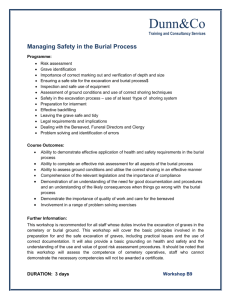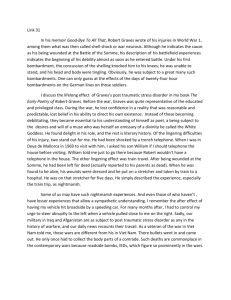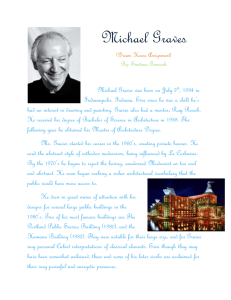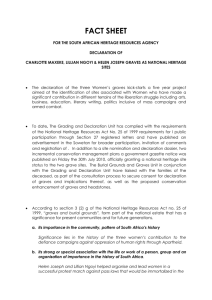Jenny Nyberg, Doktorand i arkeologi - ISV
advertisement
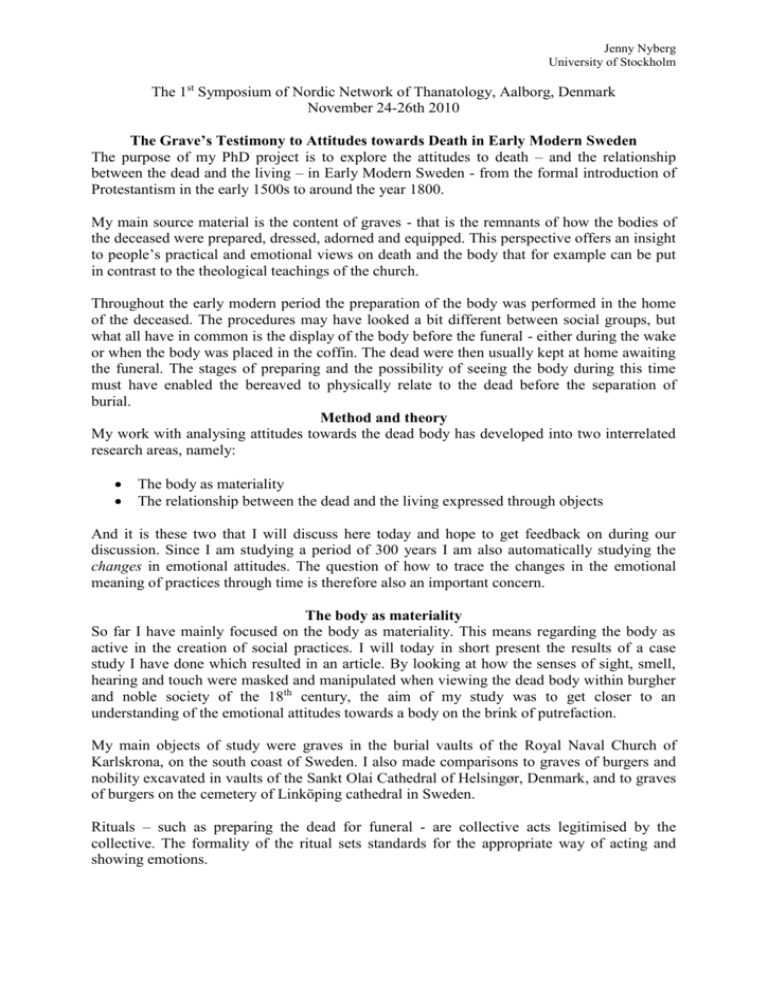
Jenny Nyberg University of Stockholm The 1st Symposium of Nordic Network of Thanatology, Aalborg, Denmark November 24-26th 2010 The Grave’s Testimony to Attitudes towards Death in Early Modern Sweden The purpose of my PhD project is to explore the attitudes to death – and the relationship between the dead and the living – in Early Modern Sweden - from the formal introduction of Protestantism in the early 1500s to around the year 1800. My main source material is the content of graves - that is the remnants of how the bodies of the deceased were prepared, dressed, adorned and equipped. This perspective offers an insight to people’s practical and emotional views on death and the body that for example can be put in contrast to the theological teachings of the church. Throughout the early modern period the preparation of the body was performed in the home of the deceased. The procedures may have looked a bit different between social groups, but what all have in common is the display of the body before the funeral - either during the wake or when the body was placed in the coffin. The dead were then usually kept at home awaiting the funeral. The stages of preparing and the possibility of seeing the body during this time must have enabled the bereaved to physically relate to the dead before the separation of burial. Method and theory My work with analysing attitudes towards the dead body has developed into two interrelated research areas, namely: The body as materiality The relationship between the dead and the living expressed through objects And it is these two that I will discuss here today and hope to get feedback on during our discussion. Since I am studying a period of 300 years I am also automatically studying the changes in emotional attitudes. The question of how to trace the changes in the emotional meaning of practices through time is therefore also an important concern. The body as materiality So far I have mainly focused on the body as materiality. This means regarding the body as active in the creation of social practices. I will today in short present the results of a case study I have done which resulted in an article. By looking at how the senses of sight, smell, hearing and touch were masked and manipulated when viewing the dead body within burgher and noble society of the 18th century, the aim of my study was to get closer to an understanding of the emotional attitudes towards a body on the brink of putrefaction. My main objects of study were graves in the burial vaults of the Royal Naval Church of Karlskrona, on the south coast of Sweden. I also made comparisons to graves of burgers and nobility excavated in vaults of the Sankt Olai Cathedral of Helsingør, Denmark, and to graves of burgers on the cemetery of Linköping cathedral in Sweden. Rituals – such as preparing the dead for funeral - are collective acts legitimised by the collective. The formality of the ritual sets standards for the appropriate way of acting and showing emotions. Jenny Nyberg University of Stockholm Emotions are partly constructed through material practice, and if certain emotions correspond with the values of society, they will be created and recreated. It is therefore my assumption that recurring patterns in graves bear witness of a collective cultural understanding. These patterns may mirror the reflected or unspoken collective emotional attitudes towards death. The study of metaphor in material culture is one way of reaching deeply rooted thoughts on death. The metaphor re-describes reality. This is often done by using concepts well known from the physical world to understand more abstract, emotional and unknown concepts such as death. Material metaphors play an important part in rituals by linking the indescribable with the experience of concrete sensory impressions. By studying the re-description of the metaphor we can reach the associations ascribed to death and thereby get closer to the emotions the participants were meant to feel. Sight When studying these graves two material metaphors become evident - the metaphors of sleep and of heavenly celebration. The sensory impressions are meant to work in a complementary fashion to make these re-descriptions of death more convincing. The dead are resting on pillows. They give the impression of having been tucked in, lying under covers or creatively draped winding sheets. Adults are shrouded in plain white cotton or linen fabric, their shrouds draped as shirts or dresses. The skin of the dead is covered to a great extent with gloves, scarves and caps. Attention is rather meant to be drawn to decorative details on clothing and winding sheets. In some cases the faces were covered by a face cloth, a paper sheet or a veil. A comparison can be made to Helsingør where all buried individuals had their face covered this way. I have seen further examples from different parts of Sweden, predominantly during the 18th century. There have probably been regional differences to this practice, and it may also be that mainly the faces of badly preserved bodies were hidden. This engraving from 1736 documenting British burial customs shows the gathering around a corpse in a noble home before the funeral. A woman in the picture removes the face cloth to take one last look. It thus enabled the mourner to decide for herself when it was time to be put face to face with the dead. If face cloth was used in the same way in Sweden I am yet to find out. The overall impression is that children’s graves are more adorned and they appear more dressed up. Their shrouds are more colourful, imitating real clothes with buttons, and great effort has been put into arranging the winding sheets in the shape of fans or halos. The vast majority of children are wearing burial coronets. They are worn as a single chaplet or in combination with a small cage shaped crown, and are mostly made of myrtle, although laurel leaf, box and lingonberry sprigs occur as well. Burial coronets are worn by children of both sexes and also adorn unmarried men and women. Coronets of myrtle were used in both weddings and funerals during the 18th century. Written sources describe how the young bride wears a coronet as a symbol of chastity and virtue. The common denominator of women and children wearing coronets is therefore that of chastity and innocence. Unmarried men did however not wear them on their head - but on their body - which I interpret as a sign of them being on their way into a more official male sphere. Laurel leaf has within Christianity been a symbol of immortality. Burial coronets thus seem to bear several related connotations. They represent a victory over death, chastity, purity and Jenny Nyberg University of Stockholm innocence and perhaps also the celebration of triumph over carnal lusts. They also suggest the celebration of a heavenly marriage to Christ. The singling out of the young and unmarried from the adult and married, performed through particular and more elaborate adornment, suggests above all a greater emotional hardship in losing someone young who had not yet fulfilled their life cycle of marrying and having children of their own. Death is portrayed as a celebration thereby focusing on a positive continuation. Smell The fragrance of herbs, such as myrtle also associated with the wedding, were also important. Rosemary was commonly used to freshen the air around the corpse. Hops was used to upholster the coffins. The tranquilizing effect of hops may also have been thought to symbolise or give a pleasant sleep to the dead. Valerian, which was found in the grave of Swedish king Gustav Vasa, dead in 1560, is to this day used as a nature cure against insomnia. Embalming had only been performed on a few bodies in the material I present here, most likely on those that due to different circumstances were hindered to be buried quickly. A simpler way of dampening the smell was the use of fir twigs found in several graves – as illustrated in this woman’s cover. There did exist an association between smell and disease, and the perfume of herbs in graves may also have been understood to fight unhealthy impurities emitted from the dead body. Hearing The bodies are resting on soft upholstery, which apart from absorbing liquids from the decomposition, also makes them lie comfortably and to a certain extent keep them from moving around inside the coffin making noises. The fastening of shrouds and winding sheets to the edge of the coffin with nails, lacquer and sealing wax must also have helped in keeping the body in place and upright – thereby making the metaphor of quiet and peaceful sleep credible. These examples illustrate how the inter-sensorial metaphors of sleep, celebration and wedding re-describe the abstract and unintelligible death in terms of well known, familiar, safe and even joyous concepts from daily life. The relationship between the dead and the living through objects Sensory impressions can, however, trigger highly individualized emotional responses. Material culture – here including the dead body – can through sight, smell, taste touch or hearing evoke memories and emotions which may lead to further action towards the dead body. Whereas recurring patterns in the way the dead are dressed, adorned and equipped can tell us of a collective cultural understanding, I believe that deviations to these patterns may tell us of actions triggered by individual emotional responses. Actions not necessarily performed or supported within the collective context of the ritual. The fact that the priest from 1684 was forbidden to take part in the final acts at home before departing to church may have further enabled such actions. There seem to have existed discrepancies between the church and the bereaved regarding what was appropriate to place in the coffin. In some cases, graves in burial vaults in churches are so well preserved that you can tell if objects were hidden or not. Objects such as a snuff box hidden in moss and a copy of Voltaire’s tragedy Oedipus hidden between the mattresses in the coffin suggests individual acts towards the dead. A very moving example is that of a stillborn baby hidden underneath the pillow of its mother who died in childbirth in 1652. It Jenny Nyberg University of Stockholm was not until the beginning of the 18th century that un-baptized children were allowed to share the grave of their parents, so this had to be done in secret. Whereas the copy of Oedipus was hidden it seems that men and women could be buried with their Bible, hymn book or prayer book visible in the coffin. This pious way of staging the dead was thus probably to the likings of the church and an officially sanctioned way of showing and burying the deceased. The fact that objects are hidden may also represent a person’s need to privately relate to the dead. Mundane objects previously used by the dead person such as a snuff box, clay pipes or a particular book have after death become emotionally meaningful and are in actions towards the dead body used to recreate a relationship. Emotionally loaded object can become extensions of the body and therefore of personhood. The dead person being unable to communicate, personhood is inferred from the outside by the bereaved – and fragments of a relationship can be recreated. Wedding rings - which become more and more common in graves during the 18th century - are both signs of the importance of marriage as an institution and of the prolongation of a relationship beyond death. Changes in the emotional meaning of practices through time When dealing with material practices that last over several hundred years, such as adorning children and the unmarried with burial coronets from the 17th to the 19th century – a question has to be raised regarding the meaning of practices over time. Part of the reason for upholding rituals and traditions is the feeling of security in doing something your ancestors have done, which may create inertia in the changing of practices. But isn’t it also very probable that the meaning of customs may change over time? One way of looking at it is as that of a gradual mutation of meaning. Cultural anthropologist Nadia Seremitakis considers each embodied performance a possible mutation of meaning and memory. The objects used in the performance have no inherent characteristics, but are loaded with meaning depending on the perceiver. Creative acts that draw upon previous experience may therefore be given a new meaning diverging from the officially sanctioned one. Embodied performance such as the adorning of the dead body can therefore involve cultural transformation as much as repetition and this can work to change the meanings assigned to objects. Historian Joseph Roache’s approach to contemporary funeral rituals in New Orleans is similar. He argues that no action or sequence can be performed exactly the same way twice – they must be reinvented and recreated at each appearance. This dynamic, re-inventive perspective may explain the continuity of practices but with slight changes in meaning. But when does a material practice cease to be? Can we assume that it is continued as long as it makes emotional sense to the people? Or is it maintained by convention until it becomes utterly unthinkable to perform for the people involved?

